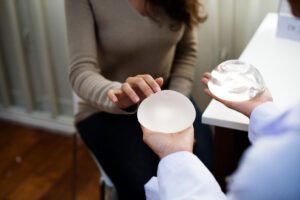Complications from plastic surgery are sometimes unavoidable no matter how competent and skilled the surgeon is. Everyone’s body is different therefore everyone reacts to surgery differently, especially if the procedure involves inserting an implant into the body. After a breast implant is placed, fibrous scar tissue forms around it as the body acclimates to the foreign object, creating a tissue capsule. This capsule is the body’s way of keeping the implant in place and is usually unnoticeable, made from soft or slightly firm tissue. Unfortunately, some bodies create abnormally hard and dense tissue called a capsular contracture. Capsular contractures squeeze the implant as it tightens around it, which can cause chronic pain and distort the shape and placement of the breasts.
The American Society of Plastic Surgeons reports that “around one in six breast augmentation patients experience some degree of capsular  contracture,” and about 75% of them occur within two years of the implants being placed. The condition is rated using a grading system based on the severity of the tissue, ranging anywhere between Grade 1 being asymptomatic to Grade 4 where the breasts are hard, painful, and misshapen. It’s also important to know it’s not caused by toxicity from the implants as saline can be safely absorbed by the body and silicone gel implants are made of medically inert silicone. Capsular contracture isn’t necessarily dangerous to the body unless the implants have ruptured.
contracture,” and about 75% of them occur within two years of the implants being placed. The condition is rated using a grading system based on the severity of the tissue, ranging anywhere between Grade 1 being asymptomatic to Grade 4 where the breasts are hard, painful, and misshapen. It’s also important to know it’s not caused by toxicity from the implants as saline can be safely absorbed by the body and silicone gel implants are made of medically inert silicone. Capsular contracture isn’t necessarily dangerous to the body unless the implants have ruptured.
Though there’s been extensive research with a slew of theories on what causes capsular contracture, the unanimous understanding is that it varies from patient to patient. Some causes are purely genetics, specifically a family history of autoimmune disease or developing thick scar tissue after an injury. Another cause is the development of a thin layer of bacteria growing around the implant if bacteria was introduced to the body via surgery. Rare complications of breast implant surgery like hematomas and seromas have also been seen to be associated with capsular contracture.
Technically, it’s not possible to prevent capsular contracture but it is possible to lower the risk of it happening. Placing implants under the chest muscles, using textured gel implants, limiting how much the implant is touched before entering the patient’s body, and thoroughly screening a patient’s health conditions have all been proven to reduce capsular contractures.
 Corrective surgery options for the condition include the capsulectomy. Working with a skilled surgeon based on the unique tissue capsule will determine what type of capsulectomy is best. Capsulectomies are an explant surgery that involves removing either a partial amount or the full tissue capsule, making space for healthy tissue. Sometimes a new implant may be inserted. During the consultation process, speaking with your doctor about your exact symptoms, your medical history, and your desired results is important when choosing a surgeon and the right corrective procedure.
Corrective surgery options for the condition include the capsulectomy. Working with a skilled surgeon based on the unique tissue capsule will determine what type of capsulectomy is best. Capsulectomies are an explant surgery that involves removing either a partial amount or the full tissue capsule, making space for healthy tissue. Sometimes a new implant may be inserted. During the consultation process, speaking with your doctor about your exact symptoms, your medical history, and your desired results is important when choosing a surgeon and the right corrective procedure.
After a capsulectomy, patients may be instructed to wear a compression bra as part of the healing process. For extensive surgeries, drainage tubes are used to decrease swelling. Generally, the recovery period for the procedure is about 2 weeks and patients are expected to quit smoking weeks before having the surgery. Research shows that 96% of patients report a significant decrease in their symptoms and 90.5% report a complete disappearance of symptoms.
Dr. Barrett has performed numerous capsulectomies with spectacular results. In one testimonial a patient said, “Dr. Barrett addressed my concerns and he and his team made me feel so comfortable about everything and gave me all the information I needed to make the decision.”
Do you want to learn more about Barrett Plastic Surgery? Keep up to date by subscribing to our blog and following us on social media at Twitter, TikTok, Instagram, Realself, YouTube, Snapchat, Yelp, and Facebook for updates.


